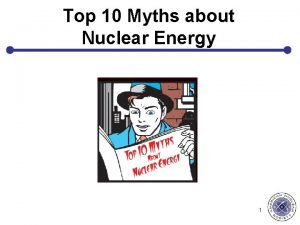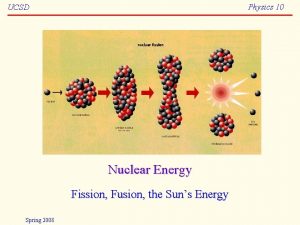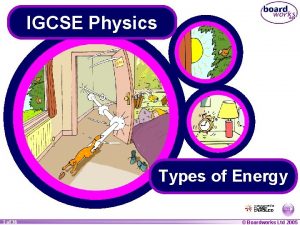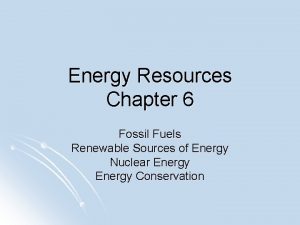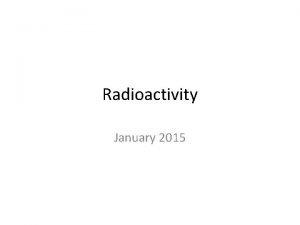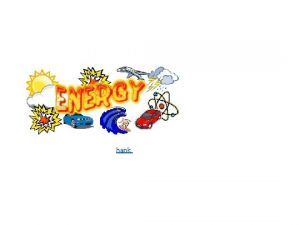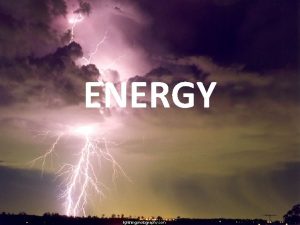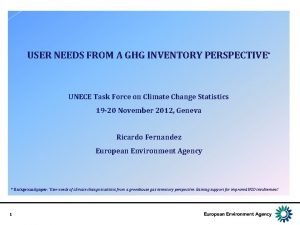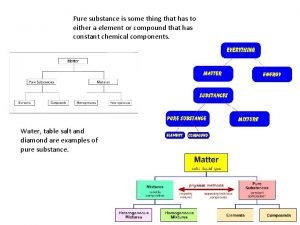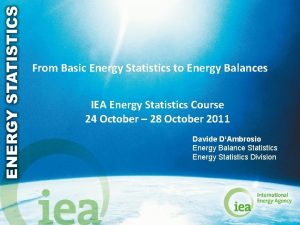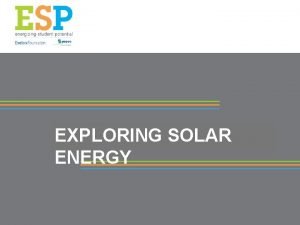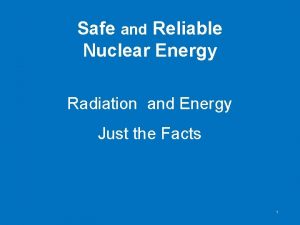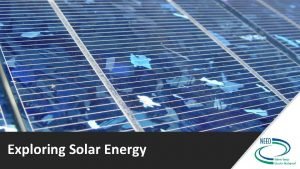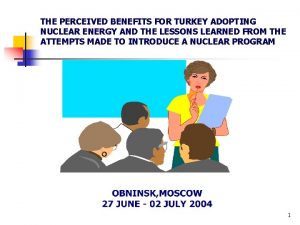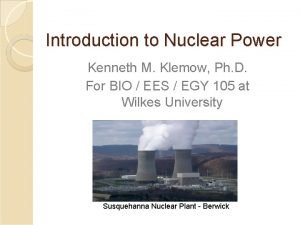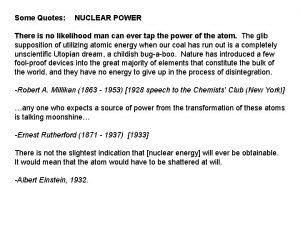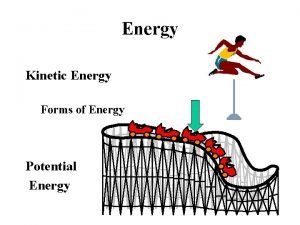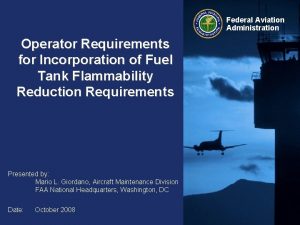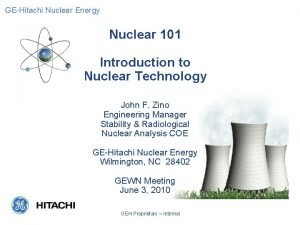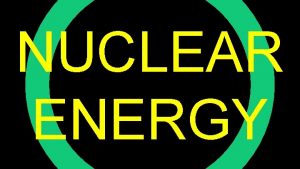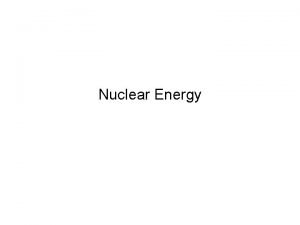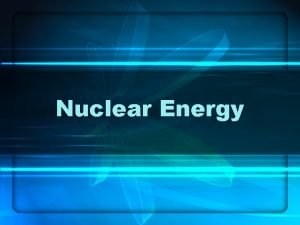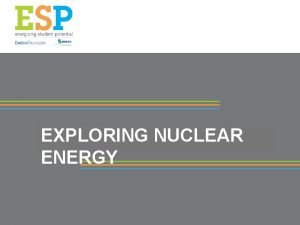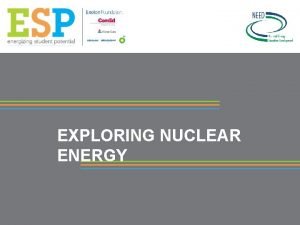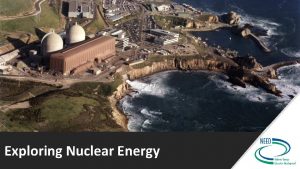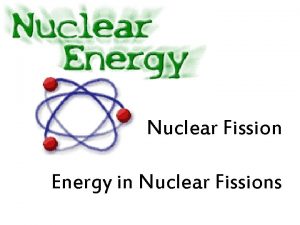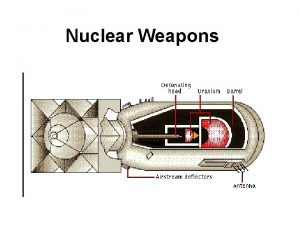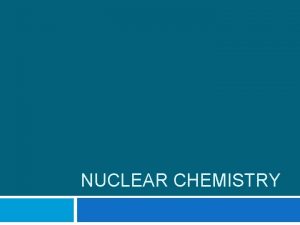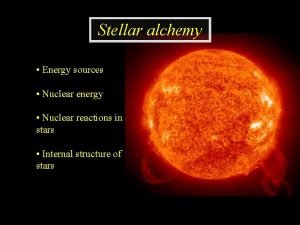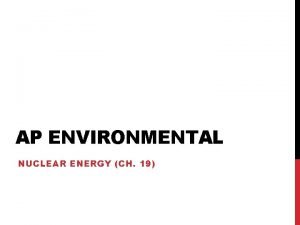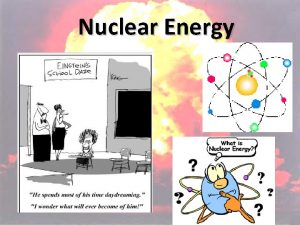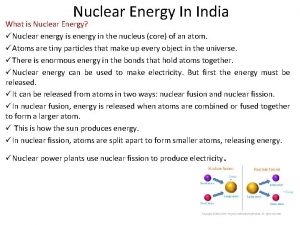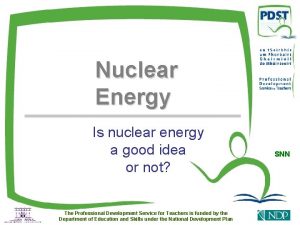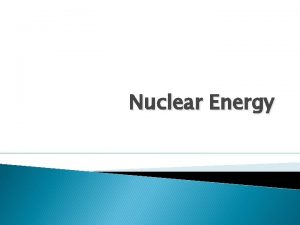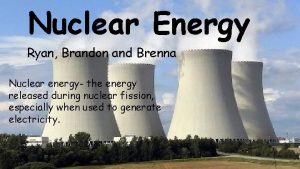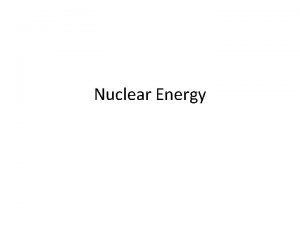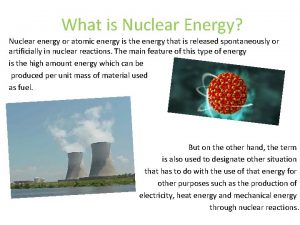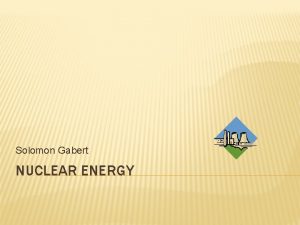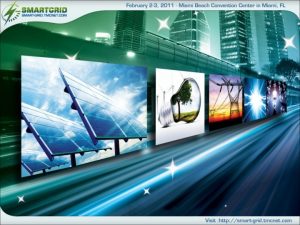Introduction to Generation IV Nuclear Energy Systems Dr

























- Slides: 25

Introduction to Generation IV Nuclear Energy Systems Dr. Ralph Bennett, Technical Director, Generation IV International Forum, and Director, International and Regional Partnerships, Idaho National Laboratory 16 Mar 2009

The Problem of Climate Change • • • Global greenhouse gas (GHG) emissions have grown since pre-industrial times, increasing 70% between 1970 and 2004 With current climate change mitigation policies and practices, global GHG emissions will continue to grow The Earth is about to undergo long lasting changes in its climate, seas and land cover, including – Temperature Global Warming (deg C) by 2100 (IPCC prediction) – Precipitation – Sea level – Ocean circulation – Ice/snow cover – Storm frequency – Storm intensity – Desertification http: //www. aip. org/history/climate/summary. htm http: //www. grida. no/climate/ipcc_tar/ 2

The Challenge for Nuclear Energy • • Nuclear is a major contributor in the WEO 2008 450 Policy Scenario— about 250 GWe more generation by 2030 (an 80% increase from today) Nuclear energy systems must continue their advances in order to unlock a potential on this scale http: //www. iea. org/weo/2008. asp 3

Generations of Nuclear Energy Generation IV Generation III+ Generation III Generation I Early Prototypes - Shippingport - Dresden - Magnox 1950 1960 Gen I Generation II Revolutionary Designs Evolutionary Designs Advanced LWRs Commercial Power 1970 - ABWR - ACR 1000 - APWR - EPR - ESBWR - CANDU 6 - System 80+ - AP 600 - PWRs - BWRs - CANDU 1980 Gen II 1990 - Safe - Sustainable - Economical - Proliferation 2000 Gen III 2010 Resistant and Physically Secure 2020 Gen III+ 2030 Gen IV http: //www. gen-4. org/Technology/evolution. htm 4

Creation of the International Forum • Started in Jan 2000 by nine countries and established Jul 2001 • Agreed that nuclear energy is needed to meet future needs • Defined four goal areas to advance nuclear energy into its next, ‘fourth’ generation: – Sustainability – Safety & reliability – Economics – Proliferation resistance and physical protection • Will collaborate to make ‘Generation IV’ systems deployable in large numbers by 2030, or earlier 5 http: //www. gen-4. org/GIF/About/origins. htm

Today’s Membership 6

Overview of the Generation IV Systems Neutron Spectrum Fuel Cycle Size (MWe) Sodium Cooled Fast Reactor (SFR) Fast Closed Very-High. Temperature Reactor (VHTR) Thermal Gas-Cooled Fast Reactor (GFR) System Missions R&D Needed 300 -1500 Electricity, Actinide Management Advanced recycle options, Fuels Open 250 Electricity, Hydrogen, Process Heat Fuels, Materials, H 2 production Fast Closed 1200 Electricity, Hydrogen, Actinide Management Fuels, Materials, Thermal-hydraulics Supercritical-Water Reactor (SCWR) Thermal, Fast Open, Closed 1500 Electricity Materials, Thermalhydraulics Lead-Cooled Fast Reactor (LFR) Fast Closed 50 -150 300 -600 1200 Electricity, Hydrogen Production Fuels, Materials Molten Salt Reactor (MSR) Epithermal or Fast Closed 1000 Electricity, Hydrogen Production, Actinide Management Fuel treatment, Materials, Reliability http: //www. gen-4. org/Technology/systems/index. htm 7

Sodium-Cooled Fast Reactor (SFR) Characteristics • • • Sodium coolant, pool or loop type 550 C outlet temperature 600 -1500 MWe large size, or 300 -600 MWe intermediate size 50 MWe small module option Metal fuel with pyroprocessing or MOX fuel with advanced aqueous separation Benefits • High thermal efficiency • Consumption of LWR actinides • Efficient fissile material generation http: //www. gen-4. org/Technology/systems/index. htm 8

SFR Reactor Options Large-scale Loop Intermediate-scale Pool Small-scale Modular 9

SFR Technology Interests • Minor actinide bearing fuel technology (fabrication, irradiation) – Metal and oxide fuel performance – Carbide fuel performance – Nitride/Carbide fuel performance • Inspection & repair technologies – Ultrasonic and alternative techniques – Replace/repair experience • High temperature leak-before-break assessment technologies – Creep-fatigue crack initiation and growth test results • Advanced energy conversion concepts – Basic design concept of supercritical CO 2 Brayton cycle system – Compact supercritical CO 2 -to-CO 2 heat exchangers 10

Very-High-Temperature Reactor (VHTR) Characteristics • He coolant • >900 C outlet temperature • 250 MWe • Coated particle fuel in either pebble bed or prismatic fuel Benefits • Hydrogen production • Process heat applications • High degree of passive safety • High thermal efficiency option http: //www. gen-4. org/Technology/systems/index. htm 11

VHTR Reactor Options Pebble bed core Prismatic-fuel core 12

VHTR Hydrogen Options Sulfur-iodine cycle High temperature electrolysis 13

VHTR Technology Interests • Fuel and fuel cycle – Particle fuel irradiations and fission product monitoring • Materials – Codes and standards extension – Materials database extension – Graphite dust behavior • Hydrogen production – – • • Sulfur-iodine cycle High temperature electrolysis Coupling of H 2 production process and reactor heat transport system Tritium transport Computational Methods Components and helium turbine – Intermediate heat exchanger 14

Lead-Cooled Fast Reactor (LFR) Characteristics • Pb or Pb/Bi coolant • 550 C to 800 C outlet temperature • Small transportable system 50150 MWe, and • Larger station 300 -1200 MWe • 15– 30 year core life option Benefits • Distributed electricity generation • Hydrogen and potable water • Replaceable core for regional fuel processing • High degree of passive safety • Proliferation resistance through long-life core http: //www. gen-4. org/Technology/systems/index. htm 15

LFR Reactor Options Small, transportable module Large, stationary plant • Pb coolant (both) • No intermediate loops 16

LFR Technology Interests • Collaborations based on ELSY and SSTAR – No formal agreement yet • Conceptual design and safety – Innovative components and design – Compact, in-vessel steam generators – Decay heat removal by air and water – Refueling ‘out-of-Pb’ coolant – Innovative structural design – Buoyant fuel element support – Seismic isolation of reactor building • Fuel and core materials – Many options ELSY: European Lead-cooled System; SSTAR: Small Secure Transportable Autonomous Reactor 17

Supercritical-Water-Cooled Reactor (SCWR) Characteristics • Water coolant above supercritical conditions (374 C, 22. 1 MPa) • 510 -625 C outlet temperature • 1500 MWe • Pressure tube or pressure vessel options • Simplified balance of plant Benefits • Efficiency near 45% with excellent economics • Leverages the current experience in operating fossilfueled supercritical steam plants • Configurable as a fast- or thermal-spectrum core http: //www. gen-4. org/Technology/systems/index. htm 18

Gas-Cooled Fast Reactor (GFR) Characteristics • He coolant • 850 C outlet temperature • Direct gas-turbine cycle or supercritical CO 2 cycle with optional combined cycles • 2400 MWth / 1100 MWe • Several fuel options – Carbide in plates or pins – Nitride – Oxide Benefits • High efficiency • Waste minimization and efficient use of uranium resources http: //www. gen-4. org/Technology/systems/index. htm 19

Molten Salt Reactor (MSR) Characteristics • Fuel is liquid fluorides of U or Th with Li, Be, Na and other fluorides • 700– 800 C outlet temperature • 1000 MWe • Low pressure (<0. 5 MPa) Benefits • Waste minimization • Avoids fuel development • Proliferation resistance through low fissile material inventory http: //www. gen-4. org/Technology/systems/index. htm 20

Organization Policy Group Senior Industry Advisory Panel Chair (France) Experts Group Policy Secretariat Chair System Steering Committees Policy Director Technical Director Co-Chairs Methodology Working Groups Proliferation Resistance and Physical Protection, Risk & Safety, Economics Technical Secretariat NEA, Paris Project Management Boards (multiple R&D projects) http: //www. gen-4. org/GIF/Governance/index. htm 21

System Partners Mar 2009 VHTR GFR SCWR LFR MSR Partners: ANRE CAEA CEA DME DOE JAEA JRC KOSEF MEST MOST NRCan PSI NRCan JRC CEA JAEA, ANRE MEST, KOSEF PSI DOE CAEA, MOST – Agency for Natural Resources and Energy (JP) – China Atomic Energy Authority (CN) – Commissariat à l’Énergie Atomique (FR) – Department of Minerals and Energy (ZA) – Department of Energy (US) – Japan Atomic Energy Agency (JP) – Joint Research Centre (EU) – Korean Science and Engineering Foundation (KR) – Ministry of Education, Science and Technology (KR) – Ministry of Science and Technology (CN) – Natural Resources Canada (CA) – Paul Scherrer Institute (CH) VHTR GFR SCWR LFR MSR DME – Very-High-Temperature Reactor – Gas-Cooled Fast Reactor – Sodium-Cooled Fast Reactor – Supercritical Water-Cooled Reactor – Lead-Cooled Fast Reactor – Molten Salt Reactor http: //www. gen-4. org/GIF/Governance/system. htm 22

Generation IV Annual Report • Captures key information and accomplishments from System Steering Committee annual reports into one widely distributed report • Captures brief summaries of working groups’ accomplishments, and background on the Forum • Audience includes: – World-wide Research and Development Community – Governments sponsoring Generation IV R&D – GIF committees, boards and working groups • The 2008 Report has just issued 23 http: //www. gen-4. org/PDFs/GIF_2008_Annual_Report. pdf

Working Toward the Future The GIF joined together to help assure a sustainable energy future • Underscored by the advance of global climate change • Based on advanced nuclear energy systems that are sustainable, safe, economical, proliferation resistant and physically secure • Accelerated by the collaboration of the GIF members, industry, academia and non-member nations and institutions 24

Bibliography • The web links provided on most slides lead to source documents, background materials or updates • The full Generation IV Roadmap and all supporting documents are available at: http: //gif. inel. gov/roadmap/ • Some technical papers are listed on the OECD NEA website (GIF website) at www. gen-4. org within each system • Recent outlook articles on nuclear deployment: – – – IEA http: //www. iea. org/weo/2008. asp (subscription) NEA http: //www. nea. fr/neo/ (subscription) IAEA http: //www-pub. iaea. org/MTCD/publications/PDF/RDS 1 -28_web. pdf WNA http: //www. world-nuclear. org/outlook/clean_energy_need. html EPRI (US R&D strategy and deployment outlook, respectively) http: //my. epri. com/portal/server. pt? Product_id=0000001018514. pdf http: //my. epri. com/portal/server. pt? Product_id=0000001018431. pdf • My contact information: – ralph. bennett@inl. gov 25
 Lesson 15 nuclear quest nuclear reactions
Lesson 15 nuclear quest nuclear reactions Fisión nuclear vs fision nuclear
Fisión nuclear vs fision nuclear First generation antipsychotics
First generation antipsychotics From generation to generation we worship you
From generation to generation we worship you Energy energy transfer and general energy analysis
Energy energy transfer and general energy analysis Energy energy transfer and general energy analysis
Energy energy transfer and general energy analysis What are fuels used for
What are fuels used for Nuclear energy in physics
Nuclear energy in physics Types of energy igcse
Types of energy igcse Nuclear energy vocabulary
Nuclear energy vocabulary Nuclear energy examples
Nuclear energy examples Bill nye energy transformation
Bill nye energy transformation Work and energy chart
Work and energy chart Nuclear energy examples
Nuclear energy examples What is the unfccc
What is the unfccc Substance
Substance Unece nuclear energy
Unece nuclear energy Radiant energy nuclear
Radiant energy nuclear Natural sources of radiation
Natural sources of radiation Nuclear energy facts
Nuclear energy facts Sun energy fusion
Sun energy fusion Nuclear energy
Nuclear energy Uses of nuclear energy
Uses of nuclear energy Quotes about nuclear energy
Quotes about nuclear energy Mechanical energy
Mechanical energy Ftfr rule
Ftfr rule






